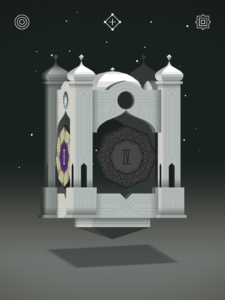Basic information
Name: Monument Valley
Creator: Ustwo Games
Platform: The game is designed for mobile devices. I played on an iPad.
Target audience: The moderate difficulty, short duration, and simple controls enable a broad target audience. This game would attract anyone who enjoys spatial puzzle games with a simple narrative and minimalistic aesthetics.
Formal elements
Players: Single player.
Objectives: Mechanically, to solve all puzzles. Narratively, to see Ida’s journey for forgiveness through to its end.
Rules & procedures: The game is split into ten chapters. Finishing a chapter unlocks the next chapter, and all unlocked chapters can be accessed from the rotating selection page. Each round begins with a brief (and often vague) description of Ida’s location and progress. Within a chapter, special locations (such as monuments and doorways) and NPCs often trigger cutscenes, in-game events (the stage warping or revealing hidden areas), or dialogue advancing the plot.

The rotating chapter selection page.
The rules are simple. The task is to get Ida to certain locations on the map (buttons, doorways, NPC, shrines, etc.). The current objective is usually clearly marked on the map. You direct Ida by tapping where you want her to go, and she moves there if possible. You can also manipulate parts of the map. Movable parts are marked by cranks or pegs. Certain parts are immovable when Ida is standing on them (indicated by the cranks retracting).
Resources: The ability to manipulate parts of the map. During certain levels, you are given access to a slidable totem which can hold down certain buttons or give Ida a boost.
Boundaries: Stages are clearly bounded. You cannot walk off the stage. At certain checkpoints, the door you walked through closes, limiting your ability to backtrack.
Outcomes: You can’t die in this game. Hence, the only outcomes are success and giving up.
Types of fun
During my playthrough, the three most significant types of fun I experienced were sensation, challenge, and narrative.
Sensation: All things aside, MV is very aesthetically pleasing to play. It features crisp, minimalistic structures in pastel environments. The soundtrack is equal parts calming and melancholic. When the map is reconfigured by player manipulation or cutscene, it often evokes surprise and wonder.
Challenge: Navigating and solving the puzzles are fun. The game teaches you the puzzle mechanics as you progress, so that when the puzzles become increasingly complex, you can combine and apply previously learned techniques (such as navigating a Penrose tribar by turning a crank, or rotating a stage to connect separated platforms) to solve them. The difficulty progression keeps the game satisfying and reasonably challenging.


The Penrose tribar is a recurring puzzle in the game.
The challenges in MV are posed by implicit mechanics as well as the explicit ones. The most significant implicit mechanic is MV’s isometric perspective, which makes it difficult to gauge the relative depths and locations of certain items and platforms. Getting accustomed to this perspective is key to navigating the puzzles. Without this sense of spatiality, the player will misjudge whether certain locations are accessible and fail to progress.
Narrative: This aesthetic is perhaps the best proof that MV is greater than the sum of its parts. By itself, the narrative is simplistic and vague. Yet combined with the mechanics of the puzzles, the narrative becomes more vibrant and immersive, as the player’s own progression gives him insight into Ida’s state of mind. For example, it’s one thing to be told that Ida is on a quest for redemption. But as the player manipulates the map to solve puzzles, he understands that his resolve (wanting to move forward) and reflections (trying to find solutions) mirror those of Ida’s quest, and he begins to feel a deeper emotional connection with the game. Because of this, when Ida achieves her goal, the player truly feels that he shares in that salvific conclusion as well.

The salvific conclusion.
Moments of particular success or epic fails
Successes: Solving a challenging puzzle is rewarding, as well as uncovering hidden mechanics. For example, I felt quite happy when I realized this box could be opened in 3 different ways, with passages connecting the various internal environments.



The puzzle box.
Fails: I got stuck on this puzzle for the longest time. I thought I had to reach the platform by moving Ida onto the totem, then moving them to the platform. But I couldn’t accomplish both tasks at once due to the map’s restrictions. I eventually realized that none of this was necessary, as I had overlooked a mechanic that lowered the platform to the ground.


The overlooked mechanical platform.
Things I would change to make the game better
More narrative coherency: The game’s plot feels a bit incoherent. Chapters often begin abruptly at seemingly random locations, and the player has no clue as to how Ida got there. I would improve this by making chapters pick up where the previous one left off.
Hints: Though the game is reasonably challenging, I’d still appreciate it if the game would give the player hints if he gets stuck for too long. I would make this function optional, so that those who want more of a challenge could turn off the hints.



